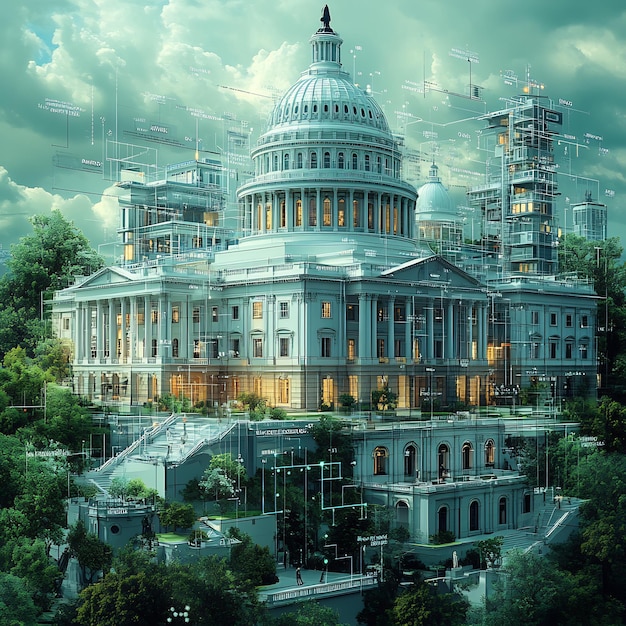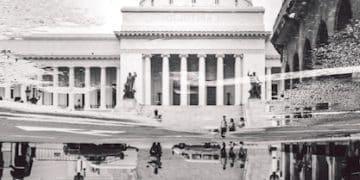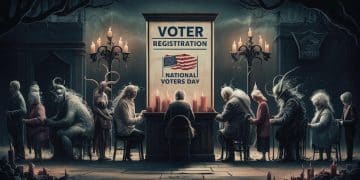2026 Midterm Elections: Finance Regulations Impact Analysis

The updated campaign finance regulations for the 2026 midterm elections are poised to significantly reshape political funding landscapes, impacting candidate fundraising strategies, super PAC influence, and the overall transparency and equity of electoral campaigns across the United States.
As the political calendar inches closer to 2026, the discussion around how campaign finance regulations will once again take center stage. The upcoming midterm elections, often a bellwether for presidential races, are primed for significant shifts due to recent and potential changes in how political campaigns are funded and regulated. Understanding how will the updated campaign finance regulations impact the 2026 midterm elections requires a nuanced look at legal precedents, technological advancements, and the tireless efforts of advocacy groups. This analysis delves into the expected ramifications, offering insights into what voters, candidates, and political observers can anticipate.
The Evolution of Campaign Finance Laws: A Brief Overview
The history of campaign finance in the United States is a convoluted tapestry of reforms, loopholes, and court challenges. Over the decades, legislative bodies and judicial rulings have continuously attempted to strike a balance between free speech rights and the need to prevent corruption or the appearance of corruption. Major milestones, such as the Federal Election Campaign Act (FECA) of 1971, which introduced disclosure requirements, and the Bipartisan Campaign Reform Act (BCRA) of 2002 (McCain-Feingold), aimed to curb “soft money” contributions, have shaped the landscape. However, landmark Supreme Court decisions, particularly Buckley v. Valeo (1976) and Citizens United v. Federal Election Commission (2010), dramatically altered the interpretation of campaign spending as a form of free speech.
These rulings have paved the way for super PACs and other independent expenditure groups, dramatically increasing the amount of money flowing into elections. Critics argue this has amplified the voices of wealthy donors and corporations, diminishing the influence of average citizens. Proponents, however, contend that such spending is a protected exercise of First Amendment rights. The tension between these perspectives continues to drive the debate and shape reform efforts.
The 2026 midterm elections will undoubtedly operate within this complex legal and historical framework. Any new regulations or interpretations will be built upon these preceding layers, creating a dynamic system that constantly adapts to new challenges and opportunities. Understanding where we’ve been is crucial to predicting where we’re going in the realm of political funding.
Key Legislative Milestones
Several pieces of legislation and court decisions have fundamentally reshaped campaign finance:
- Federal Election Campaign Act (FECA): Established the Federal Election Commission (FEC) and set contribution limits.
- Bipartisan Campaign Reform Act (BCRA): Banned soft money and regulated issue ads.
- Citizens United v. FEC (2010): Affirmed independent political spending by corporations and unions as free speech.
- McCutcheon v. FEC (2014): Struck down aggregate limits on individual contributions.
Each of these events has left an indelible mark, influencing how campaigns are funded and how money flows through the political system. The ongoing debate about money’s role in politics ensures that these regulations are always under scrutiny and subject to potential change.
These legal shifts have not occurred in a vacuum; they reflect societal values, technological advancements, and evolving political strategies. The interplay between law, technology, and public opinion ensures that campaign finance remains a moving target, constantly adapting to the demands of a modern democracy.
Anticipated Changes in Disclosure Requirements for 2026
Transparency is a cornerstone of democratic accountability, yet campaign finance disclosure requirements have consistently been a point of contention. For the 2026 midterm elections, we might witness significant pushes for enhanced disclosure, particularly concerning “dark money” groups that can spend unlimited amounts without revealing their donors. Advocacy groups on both sides of the aisle often agree that more information benefits the electorate, though they diverge on the specifics of what needs to be disclosed and by whom. One major area of focus for potential regulatory updates is the origin of funds for independent expenditure-only committees, commonly known as super PACs. While these groups must disclose their expenditures, the sources of their donations often remain opaque, shielding deep-pocketed benefactors from public scrutiny.
Pressure from good governance organizations and public interest groups could lead to renewed legislative efforts to broaden the scope of disclosure. This might include mandating a more rapid reporting schedule for large contributions or expanding the definition of what constitutes a political expenditure, thereby subjecting more financial activity to public disclosure. Conversely, there could be challenges to existing disclosure laws, arguing they infringe on privacy or deter civic engagement. The exact nature of any changes will likely depend on the political momentum leading up to the midterms and the composition of Congress and the Supreme Court.
Potential Impact of Enhanced Transparency
If new disclosure rules are implemented, their effects could be wide-ranging:
- Increased public awareness of donor influence.
- Greater accountability for political spending.
- Strategic adjustments by campaigns and PACs to comply or adapt.
Furthermore, technological advancements could simplify the processing and accessibility of disclosed data, allowing journalists and the public to more easily track the flow of money. Blockchain technology, for example, has been proposed as a way to enhance transparency and traceability, though its implementation in campaign finance remains largely theoretical. The goal would be to ensure that voters have a clearer picture of who is funding political messages and why, fostering more informed decision-making.
The impact of these changes would not be uniform. While some campaigns might find increased scrutiny challenging, others might leverage greater transparency as a way to build trust with their constituents. The interplay of new regulations and strategic responses will define the financial landscape of the 2026 midterms.
The Role of Super PACs and Independent Expenditures
Super PACs have become indelible fixtures in modern American elections, capable of raising and spending unlimited sums of money to advocate for or against political candidates, provided they do not coordinate directly with campaigns. Their influence has grown exponentially since the Citizens United decision, often outspending traditional party committees and significantly shaping the narrative of campaigns. For the 2026 midterms, the regulatory environment around these entities is likely to be a hotbed of activity. While direct limits on their spending are unlikely, given current judicial precedent, efforts to refine or enforce existing rules could have a substantial impact.
One area of ongoing debate centers on the definition of “coordination” between super PACs and campaigns. Loopholes often allow for indirect communication or the leveraging of publicly available information, blurring the lines that are supposed to keep these entities independent. Reforms could seek to clarify these definitions or strengthen enforcement mechanisms, which would force super PACs to operate with greater distance from the candidates they support. This could alter their strategies, moving them away from real-time campaign adjustments and towards more strategic, longer-term messaging efforts.
Conversely, there’s always the possibility of legal challenges that could further loosen restrictions on independent expenditures. Arguments around free speech and the practical difficulties of regulating complex financial flows continue to be potent forces in the courts. Therefore, predicting the exact role of super PACs in 2026 involves anticipating both legislative and judicial developments. Their sheer financial power means that any regulatory shift, however subtle, can have profound effects on competitive races.
Potential Shifts in Super PAC Operations
Several factors could influence how super PACs operate in 2026:
- Stricter enforcement of non-coordination rules.
- Increased scrutiny of their funding sources.
- Technological advancements in microtargeting voters.
The ability of super PACs to raise and spend vast amounts of money means they can significantly amplify certain messages or target specific demographics with highly tailored advertisements. This capacity for sophisticated campaign operations ensures their continued centrality in electoral contests. Any regulatory changes that temper or enhance this power will ripple throughout the political system.

Ultimately, the balance between allowing robust independent speech and preventing undue influence will remain a key challenge. The 2026 midterms will serve as a critical testing ground for whatever regulatory framework is in place, demonstrating its effectiveness and revealing any new vulnerabilities.
Dark Money and the Rise of “Social Welfare” Organizations
“Dark money” refers to political spending by nonprofit organizations that are not required to disclose their donors. These groups, often registered under sections 501(c)(4) of the tax code as “social welfare” organizations, can exert significant influence in elections by running issue ads, endorsing candidates, and engaging in other political activities, as long as politics is not their “primary” purpose. The ambiguity of “primary purpose” has allowed for vast sums of undisclosed money to flow into campaigns, fueling concerns about accountability and the integrity of elections. The 2026 midterm elections will undoubtedly see these organizations play a critical role, and any regulatory changes affecting them could significantly alter the political landscape.
Efforts to tackle dark money typically involve legislative attempts to mandate disclosure for groups engaged in substantial political spending, regardless of their tax designation. These efforts often face stiff opposition, with opponents arguing that such disclosure requirements would infringe on donor privacy and free association rights. However, public and governmental pressure for transparency remains strong, particularly in the wake of high-spending elections where the sources of significant funding remain unknown. The Federal Election Commission (FEC) has had limited success in addressing this issue due to partisan gridlock, often resulting in enforcement stalemates.
Any significant shifts in this area would likely require either new legislation or a more unified FEC, which has historically been difficult to achieve. Alternatively, state-level initiatives might emerge as a patchwork solution, with some states implementing stricter disclosure rules than others, impacting races differently across the country. The ongoing debate around dark money underscores the tension between free speech and the need for a transparent and equitable political system. How this tension is resolved, or at least managed, will be a defining feature of the 2026 midterms.
Key Concerns with Dark Money
The undisclosed nature of dark money raises several critical questions:
- Lack of donor accountability and potential for foreign influence.
- Skewed public perception due to hidden agendas.
- Undermining of public trust in democratic processes.
Moreover, the influx of dark money can create an uneven playing field, where campaigns with access to these undisclosed funds possess a formidable advantage. The ability to launch highly sophisticated, often misleading, advertising campaigns without revealing who is behind them can profoundly affect voter behavior and electoral outcomes. As we approach 2026, the discussion around reining in dark money will intensify, reflecting broad public desire for more clarity in political funding.
The challenge lies in enacting reforms that withstand legal scrutiny and effectively balance constitutional rights with the imperative of a transparent democracy. The outcome of this struggle will dictate the level of transparency (or opacity) in the 2026 midterm elections.
Impact on Grassroots Fundraising and Small Donors
While large contributions and super PACs often dominate headlines, the collective power of small donors and grassroots fundraising remains a vital component of political campaigns. Updated campaign finance regulations for the 2026 midterms could significantly affect the strategies candidates employ to engage the public and solicit smaller contributions. Historically, regulations have often focused on limiting large donations and corporate spending, sometimes inadvertently creating avenues for the proliferation of small-dollar fundraising, especially through online platforms. Technologies like ActBlue and WinRed have revolutionized how small donations are collected, making it easier for everyday citizens to contribute.
One potential regulatory impact could be an emphasis on matching systems for small contributions, similar to programs implemented in some cities and states. These systems amplify the impact of small donations, incentivizing candidates to focus more on broad-based support rather than solely pursuing wealthy individual donors. Such reforms aim to level the playing field, ensuring that candidates are accountable to a wider electorate rather than a select few. Conversely, overly complex or burdensome reporting requirements for small donations could inadvertently discourage grassroots efforts, creating administrative hurdles for campaigns that rely on volume rather than size of contributions.
The digital nature of modern grassroots fundraising also presents unique challenges. Regulations around online solicitations, data privacy for donors, and the use of artificial intelligence in targeting potential small donors are areas ripe for legislative or administrative guidance. The goal is to maximize participation while safeguarding against fraud and ensuring ethical practices. For 2026, candidates who effectively harness digital fundraising tools, while adapting to any new regulatory frameworks, will likely have a distinct advantage in mobilizing their base and funding their campaigns.
Enhancing the Role of Small Donors
Several measures could empower small donors more effectively:
- Public matching systems for small contributions.
- Simplified online donation platforms with clear disclosure.
- Tax incentives for small-dollar political donations.
The democratic ideal of widely distributed political power is often tied to the ability of many individuals to contribute meaningfully to political discourse, not just financially. By fostering an environment where small donations are highly valued and easily facilitated, the 2026 midterms could represent a significant step towards a more inclusive and representative funding model. The strategic focus on grassroots engagement not only funds campaigns but also energizes voter bases and builds stronger community ties.
The Evolving Landscape of Digital Political Advertising
The digital realm has fundamentally transformed political campaigning, and with it, the landscape of political advertising. As we look towards the 2026 midterm elections, updated campaign finance regulations will almost certainly grapple with the complexities of online political ads, social media influence, and the burgeoning use of artificial intelligence in targeting voters. Unlike traditional television or radio ads, digital advertising can be highly granular, microtargeting specific demographics with tailored messages, often without clear disclosure of who is behind the ad or how much was spent. This opacity and precision pose significant challenges for existing regulatory frameworks.
One key area for potential reform is the extension of disclosure requirements to platforms like Facebook, Google, and X (formerly Twitter). Currently, regulations vary, and the speed at which digital ads can be created, disseminated, and removed makes oversight difficult. Legislators and regulators may seek to impose stricter rules on what constitutes a “political ad” online, requiring platforms to maintain publicly accessible databases of all political advertising, including who paid for it and the target audience. This would provide greater transparency and allow for better tracking of influence campaigns.
Furthermore, the ethical implications of AI in political advertising are becoming increasingly salient. The use of generative AI to create deepfakes, highly personalized messages, or manipulated content could mislead voters and undermine democratic processes. Future regulations might address the provenance of AI-generated content in political ads, requiring clear labeling or even outright bans on certain malicious uses. The balance between protecting free speech and preventing disinformation will be a delicate one, but for 2026, expect significant attention to be paid to how money shapes the digital political conversation.
Regulating the Digital Front
Addressing the challenges of digital political advertising could involve:
- Mandatory disclosure for online ad platforms.
- Clear definitions for digital political content.
- Guidelines or restrictions on AI-generated political material.
The pervasive nature of social media means that voters are constantly exposed to political content, often without fully realizing its origins or intent. Ensuring that campaign finance regulations keep pace with technological advancements is essential for maintaining a fair and honest electoral process. The 2026 midterms will serve as a crucial test for the effectiveness of any new rules in bringing greater accountability to the digital sphere.
Challenges and Opportunities for Campaign Finance Reform in 2026
Campaign finance reform in the United States is a perpetual cycle of legislative efforts, judicial review, and strategic adaptation by political actors. For the 2026 midterm elections, the challenges and opportunities remain substantial. On one hand, deep partisan divisions and differing constitutional interpretations often lead to legislative gridlock, making comprehensive reform difficult. Efforts to limit spending frequently face constitutional challenges, while proposals for enhanced disclosure are often met with resistance due to concerns about donor privacy. The Federal Election Commission (FEC), the primary agency tasked with enforcing campaign finance laws, often struggles with a lack of quorum or partisan deadlocks, hindering its ability to effectively regulate.

On the other hand, the appetite for reform among the public and various advocacy groups remains strong. Opportunities for change could arise from a renewed push for judicial review that reconsiders the premise of money as unlimited free speech, though this is a long shot given the current Supreme Court composition. More realistically, public opinion could galvanize state-level reforms, creating a patchwork of different regulations that might inform future federal legislation. Technological advancements also present both challenges and opportunities: while they complicate oversight, they also offer new tools for transparency, such as data analytics for tracking money flows and blockchain for secure record-keeping.
Ultimately, the impact of updated campaign finance regulations on the 2026 midterms will depend on a confluence of political will, judicial interpretations, and external pressures. Whether reforms lead to a more equitable and transparent system, or if political money continues to find new avenues of influence, remains to be seen. The ongoing debate underscores the fundamental American tension between individual liberties and the collective good of a robust democracy. The next few years will be critical in shaping how these foundational issues play out in electoral politics.
Potential Avenues for Reform
Despite the challenges, several pathways for reform are frequently discussed:
- Constitutional amendment to clarify money’s role in politics.
- Executive orders on federal contractor political spending.
- State-level initiatives and pilot programs for public financing.
These reform efforts are not merely theoretical; they represent active legal and political battles being fought across the country. The 2026 midterms will invariably be influenced by the outcomes of these struggles, highlighting the dynamic and often unpredictable nature of campaign finance regulation. The continued evolution of these laws reflects society’s ongoing attempt to define the appropriate role of wealth in a democratic system, ensuring that elections are decided by voters, not by dollars.
| Key Point | Brief Description |
|---|---|
| 📊 Disclosure Requirements | Potential for stricter rules on revealing donor identities, especially for “dark money” groups, increasing transparency. |
| 💲 Super PAC Influence | Debates over “coordination” definitions and enforcement could alter how independent expenditure groups operate. |
| 📢 Digital Ad Scrutiny | New regulations expected for online political advertising, including transparency and AI content guidelines. |
| 🤝 Grassroots Funding | Focus on empowering small donors, potentially through matching systems, countering large contributions. |
Frequently Asked Questions About Campaign Finance
“Dark money” refers to political spending by nonprofit organizations, typically 501(c)(4) groups, that are not legally required to disclose their donors. These groups can spend unlimited amounts on political activities, such as issue ads, as long as politics is not their “primary” purpose. This lack of transparency makes it difficult to track who is influencing elections.
Super PACs (independent expenditure-only committees) can raise and spend unlimited amounts of money from corporations, unions, associations, and individuals. Unlike traditional PACs, they cannot donate directly to candidate campaigns or coordinate with them. Traditional PACs have strict limits on contributions received and given to campaigns.
There is strong pressure to increase regulation on digital political advertising for the 2026 midterms. This could include stricter disclosure requirements for online platforms, clearer definitions of political ads, and possibly guidelines or restrictions concerning AI-generated content to combat disinformation and enhance transparency.
New regulations could both help and hinder grassroots fundraising. While efforts like public matching systems could amplify small donations, overly complex reporting requirements might create administrative burdens. The goal is often to empower small donors, shifting focus from large contributions to broad-based support, provided regulatory mechanisms are efficient.
The FEC is the primary federal agency responsible for enforcing campaign finance laws. Its role in updated regulations for 2026 will be crucial in interpreting new laws, issuing guidance, and investigating violations. However, partisan gridlock within the FEC has often limited its effectiveness, making consensus on significant enforcement or new rules challenging.
Conclusion
The 2026 midterm elections are set to occur within a dynamic and frequently contentious campaign finance landscape. The interplay of past legal precedents, ongoing reform efforts, and technological advancements will undoubtedly shape how campaigns are funded, how messages are disseminated, and ultimately, how voters engage with the political process. Navigating these complexities requires a keen understanding of both the intent behind campaign finance regulations and their practical application. As the country moves closer to these crucial elections, the debate around money in politics will continue to underscore fundamental questions about fairness, transparency, and the balance of power in American democracy.





